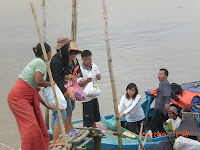Philippine Daily Inquirer/OPINION/by Ma. Ceres P. Doyo
WHILE WE continue to reel from the series of bad news—disasters, heinous crimes, bombing of innocents, accidents, price increases, etc.—that have sprung on us as 2011 began to unfold, we have not been bereft of good news.
The case of Catherine Erica Buenaventura was a big ray of sunshine that came during these crazy weather days. And it was not just about her, it was about so many people that were part of the miracle that slowly unfolded. Women and men of science and medicine, people and institutions in the service of the sick and needy, individuals who quietly gave of themselves financially, bodily, unselfishly without thought of rewards, and parents and next of kin who, armed only with faith that God would deliver the near impossible, never gave up.
Here was a frail little girl, all of three years, who could just have been slowly decimated by a deadly ailment—end-stage liver disease—and could have been given up as near dead. Erica was also suffering from portal hypertension or an increase in blood pressure in a system of veins within the stomach intestine, spleen and pancreas. She had malnutrition and bleeding in the veins and around the esophagus, both complications related to portal hypertension.
When I received notice from The Medical City (TMC) about Erica’s case, I didn’t think twice and went to the press briefing. The venue was full of medical personnel in their white jackets. So many of them, I thought, just as many as the media people present. Dr. Alfredo Bengzon, chair and CEO of TMC, gave the opening statement.
Here was a first. The first pediatric liver transplant on a Filipino child to be performed in the Philippines. The first to be performed by an all-Filipino team of doctors.
Two simultaneous operations took place on Jan. 7. Erica’s diseased liver was removed entirely. A part of her 18-year-old uncle Jefferson Llantino’s liver was also removed, after which it was grafted to where Erica’s liver used to be. The entire procedure took almost 24 hours, from 7 a.m. of Jan. 7 to the early morning hours of Jan. 8.
After the operation, Erica was brought to the hospital’s pediatric ICU where she remained for eight days. On Jan. 16, Erica was transferred to a regular room. The head of the transplant team, Dr. Vanessa H. de Villa, described Erica’s fast post-operation recovery as extraordinary with her new liver functioning well.
And Jefferson the liver donor? He has recovered fully and was discharged from the hospital on Jan. 14. De Villa said that Jefferson’s liver will regenerate fully in a couple of months. Jefferson, a computer buff and budding animé artist, sporting an animé hairstyle and all, was at the press conference to say a few words about why he did what he did. To paraphrase what he said in Filipino: “And why not, if we could give part of ourselves in order to help others?” I almost burst into tears.
Liver disease is common in the Philippines and affects both adults and children. The most common liver diseases among adults are chronic hepatitis B infection, alcoholic liver disease and non-alcoholic fatty liver disease. One in five with these conditions would develop cirrhosis, liver failure or liver cancer.
Erica had biliary atresia, a disease of the bile ducts that affects one in 15,000 children, that developed into liver failure. Liver transplantation was the only option for her and for countless children like her. Sadly, the Philippines had been left behind in this department.
But not anymore. The team that performed the transplantation was as good as any. De Villa, director of TMC’s Center for Liver Disease Management and Transplantation, had spent years in some of the best transplant centers in the world. She had worked in Hong Kong and Taiwan where a number of Filipino children with liver disease had gone for treatment. Now she is back.
Also in the surgical team were hepatobiliary and transplant surgeons Drs. Allan Concejero, Dante Ang and Anthony Yap; plastic and reconstructive/microsurgery surgeons Drs. Eric Arcilla and Catherine Asedillo. And there were the anesthesiologists, pediatric gastroenterologists, adult hepatologists, pediatric intensivists, cardiologists, radiologists, pathologists, developmental pediatricians, a rehab specialist. I wish I could mention all their names.
Around to observe the Filipino surgical team at work were De Villa’s colleagues from Hong Kong. Erica’s doctors were assisted by more than 50 professionals from nursing, laboratory, radiology, pharmacy, nutrition and physical therapy departments.
That was the medical part. The Philippine Charity Sweepstakes Office (PCSO) played a big part in this feat. There were individuals, too, who gave their share. A number of them had read about the plea of Erica’s parents, Christian and Carmela, in the Inquirer. Carmela tearfully recalled how doors closed on her (“Erica will die anyway”) and how so many doors also opened. But one thing led to another, and soon the walls just broke open.
PCSO head Margie Juico announced that one good deed deserved another. And so Jefferson, the liver donor, will no longer have to worry about his computer education and anime dreams. The PCSO will take care of that. And of course, for the long haul, the PCSO will be there for Erica’s medical needs, Juico assured.
It’s awesome. A whole village, so to speak, of health experts and service-oriented groups and individuals trying to save the life of a child and showing that it can be done. Yes, the entire procedure, when quantified, cost millions. But one cannot put a price tag on this miracle. And other miracles to come.
The forces of the entire universe conspired to give Erica a new lease on life so that the goodness, gifts and skills of Filipinos would be revealed.













